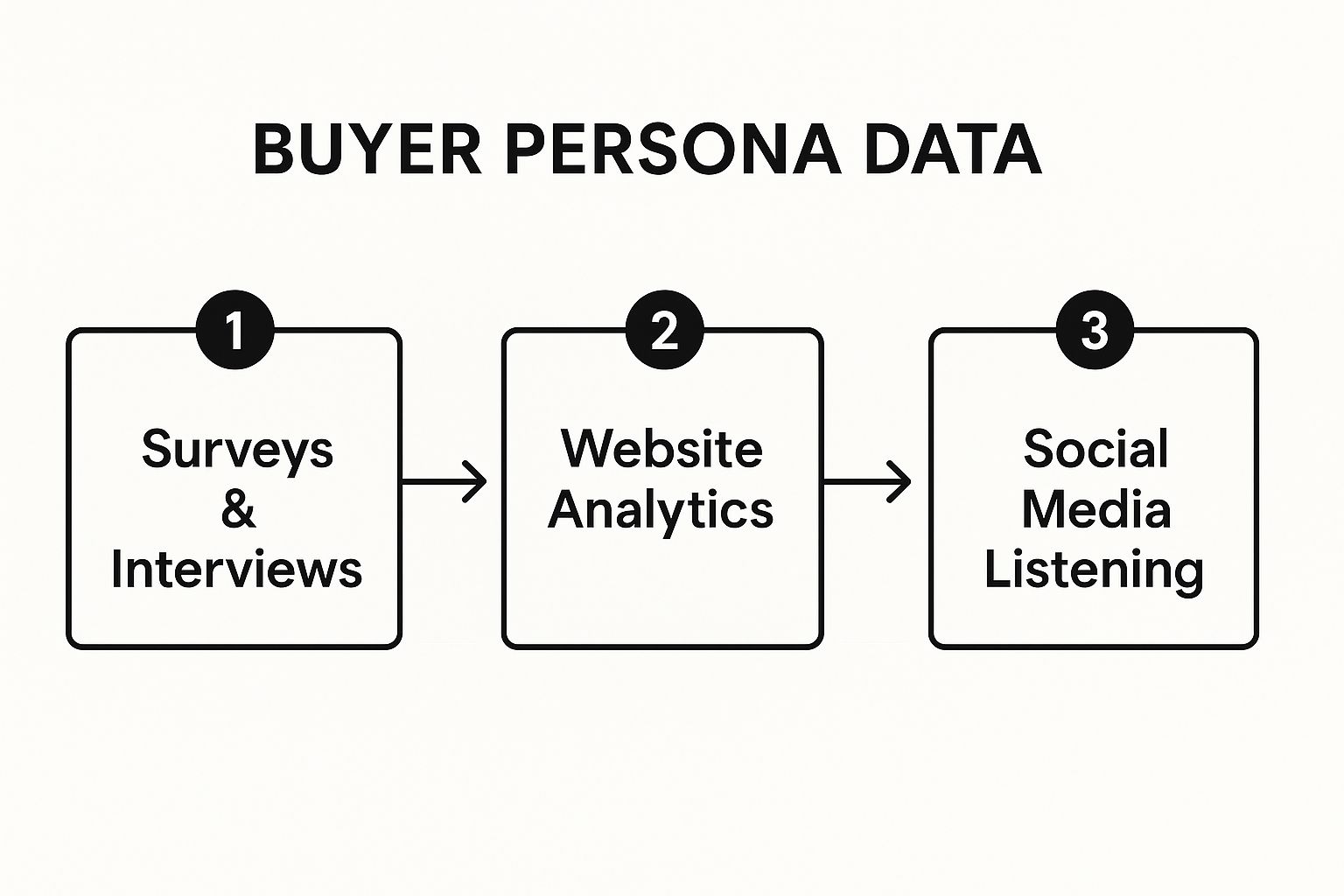Creating a buyer persona isn't just about filling out a template. It's about blending hard data from market research and customer analytics with the real, human stories you get from direct interviews. This process transforms faceless data points into relatable characters that can genuinely guide your marketing, sales, and even product development.
Why Most Buyer Personas Fail (And How Yours Won't)

Let's be honest. Most buyer personas are doomed from the start. They’re cooked up in a single workshop, packed with assumptions, and then exiled to a forgotten folder on a shared drive, never to be seen again. This is what happens when personas are treated like a checkbox item instead of the living, breathing strategic tool they’re meant to be.
The biggest mistake? A total disconnect from reality. Creating a persona named "Marketing Mary" who "enjoys yoga and lattes" is useless. It’s fluff. It does absolutely nothing to help your sales team navigate a complex deal or your content team write a compelling article. When personas lack a solid foundation of both real conversations and hard data, they’re just an exercise in creative writing.
The Real Job of a Persona
A truly effective buyer persona is much more than a demographic checklist. It's a strategic tool built to create genuine empathy and get your entire organization on the same page, all focused on the customer. When you get it right, everyone—from the newest marketing hire to the head of product—can answer one simple question: "What does our customer actually need from us?"
I once worked with a B2B software company that was drowning in low-quality leads. Their messaging was painfully generic, aimed at "small business owners," which is about as specific as targeting "people who breathe air." The result was a sky-high bounce rate and a sales team burning hours on calls with people who were never going to buy.
After we dug in and built a couple of data-backed personas, everything changed. They stopped talking to a vague audience and started speaking directly to "Growth-Focused Gary," a tech-savvy founder swamped by day-to-day operations, and "Cautious Carol," a budget-conscious manager who needed a mountain of social proof before she’d even consider a demo.
This clarity was a game-changer. They tailored their blog posts, ad campaigns, and email sequences to speak directly to Gary's ambitions and address Carol's specific hesitations. The one-size-fits-all approach was out, and targeted, relevant outreach was in.
The Bottom-Line Impact of Doing This Right
This isn't just a "nice-to-have" marketing exercise; it has a direct and measurable impact on your bottom line. Companies that truly put the customer first—using tools like personas to get inside their audience's head—are 60% more profitable than those that don't.
And with 44% of marketers already using personas to shape their campaigns, you're not just missing an opportunity by skipping this step—you're actively falling behind competitors who are building stronger connections with your ideal customers. You can dive deeper into these buyer persona statistics to see the full picture.
In the end, a great persona changes everything. It turns abstract data into a compelling human story that leads to smarter decisions and, most importantly, real revenue growth.
Start With the Data You Already Have
Before you ever think about scheduling an interview or sending out a survey, the first place to look is right under your own roof. The most powerful, effective buyer personas are built on a bedrock of real data, not just good guesses. You're probably sitting on a treasure trove of information that can give you a solid, evidence-based starting point.
This isn't just about gut feelings anymore. The game has changed. Today, smart companies blend those qualitative stories with hard, quantitative data from their web analytics and CRM. A fintech company, for example, saw its revenue jump by 29% and new customer acquisition grow by 15% after they started using data-driven personas. If you want to see the full impact, you can read more about these data-driven persona findings.
Dig Into Your CRM and Sales Data
Your Customer Relationship Management (CRM) system is your ground zero. Think of it as a living history of every person who has already decided your solution was the right one for them.
It's time to put on your detective hat and look for patterns in the information your sales team has been logging for years.
- Who are they, really? Are you consistently selling to VPs of Marketing, IT Directors, or Heads of People? Note the common job titles.
- What size company are they in? Do your happiest customers come from scrappy startups with fewer than 50 employees, or are they from massive enterprise corporations? Look at company size.
- What world do they live in? Are you seeing clusters of customers in specific industry verticals like SaaS, manufacturing, or healthcare?
This initial dig gives you a surprisingly clear snapshot of who's already buying from you. For B2B, you can take this a step further by using company information databases to add more texture and detail about the organizations themselves.
To help you get started, here's a quick-reference guide for pulling the most valuable quantitative data from your existing tools.
Key Quantitative Data Sources and What to Look For
| Data Source | Key Metrics to Analyze | What This Tells You |
|---|---|---|
| CRM (e.g., Salesforce, HubSpot) | Job Titles, Company Size, Industry, Lead Source, Deal Size | Who your ideal customer is and how they found you. |
| Website Analytics (e.g., Google Analytics) | Top Pages, Referral Sources, User Demographics, On-site Search Queries | What problems they're trying to solve and where they hang out online. |
| Support Desk (e.g., Zendesk, Intercom) | Ticket Categories, Common Questions, Feature Requests, Frustration Points | Their real-world pain points and goals, in their own words. |
This table is just a starting point, but it shows how different platforms provide different pieces of the same puzzle. By combining these insights, a clear picture of your customer begins to emerge.
Analyze Your Website Analytics
Next up, pop the hood on your website analytics platform, like Google Analytics. This is where you can see exactly how people find you and what they care about once they get to your site.
You're looking for the story behind the clicks.
- Top-Performing Content: Which blog posts, guides, or landing pages are getting all the attention? This is a huge clue about what topics resonate most deeply with your audience.
- Referral Sources: Where is your traffic coming from? Organic search? A specific industry blog? LinkedIn? This tells you where your audience spends their time online.
- Demographic Data: Don't forget the basics. Check out the age, gender, and location reports to add some simple demographic layers to your profiles.
This data gives you the "what" and "where" of your audience's behavior.

As you can see, this quantitative data provides the skeleton. Later, you'll add the flesh and blood with qualitative research like interviews and surveys.
Uncover Clues in Customer Support Tickets
Last but not least, don't forget about your customer support logs. This is where you find the raw, unfiltered voice of your customer. It’s a goldmine of their real-world frustrations, challenges, and goals, all expressed in their own words.
Sift through those support conversations and look for recurring themes. Are people constantly asking how to integrate your tool with another specific piece of software? Do they keep mentioning a bottleneck in their workflow? These aren't just support tickets; they are direct clues about their biggest pain points.
By piecing together the clues from your CRM, website analytics, and support channels, you can build a surprisingly accurate first draft of your buyer personas. This data-first approach ensures your personas are grounded in reality from the very beginning, long before you ever ask a single customer a question.
Get the Real Story with Qualitative Research

All that quantitative data you just collected? It’s a great start. Think of it as the skeleton for your buyer persona—it gives you the basic structure, the what and the where of your audience's behavior. But a skeleton isn't a person. To bring your persona to life, you need to add the flesh and blood. That's where qualitative research, which is really just a fancy way of saying "talking to actual people," comes in.
Analytics can tell you that your blog post on project management integrations is a huge hit, but they can't tell you why. Are your readers totally fed up with their current tools? Are they scrambling to build a business case for new software to show their boss? This is the human story that turns a generic label like "IT Manager, age 45" into "Ian, the overwhelmed IT Director who’s drowning in disconnected systems."
The Art of the Customer Interview
Hands down, the single most powerful tool you have for this is the customer interview. The goal isn't to fire off a list of questions like an interrogation. It's to have a genuine conversation. You want to create a relaxed atmosphere where people feel comfortable enough to share what’s really on their minds.
Your current customer base is the perfect place to start digging. They already chose you for a reason, so they definitely have a story to tell. But don't just talk to your biggest fans. Some of the most valuable insights I've ever gotten came from talking to customers who were struggling or even those who had already left. They’ll give you the unvarnished truth about friction points and where you're falling short.
My biggest piece of advice for interviews is to lean into open-ended questions. Instead of asking, "Do you find our reporting feature easy to use?"—which just gets you a 'yes' or 'no'—try something like, "Could you walk me through how you put together your last monthly report?" This simple shift encourages them to tell a story, revealing their entire process, their frustrations, and the moments they actually found value.
This approach gives you the context behind their clicks. You're not just learning about your product anymore; you're learning about their world.
Asking Questions That Uncover Real Motivation
Getting this right really comes down to crafting good questions. You want to get past the surface-level stuff and dig into their real goals and headaches. Avoid questions that steer them toward the answer you want to hear.
Here are a few powerful questions I always keep in my back pocket:
- Goals: "What does a really great, productive day at work look like for you?"
- Challenges: "What's the most frustrating, time-sucking part of your job right now?"
- Watering Holes: "When you're stuck on a work problem, where's the first place you go online for answers?"
- Decision-Making: "Think back to the last time you bought new software. Could you walk me through how that whole process went down?"
Each one of these questions is an invitation to share a story. Once you understand their daily battles and what they’re trying to achieve, you can position your product as an actual solution to their problems, not just another tool. This level of insight is also a goldmine for effective competitive intelligence gathering, because it reveals why they chose you over someone else.
Mining for Gold on Social Media and Forums
Beyond one-on-one interviews, there's a treasure trove of candid, unfiltered opinions waiting for you online. Think of social media and forums as a way to be a fly on the wall where your audience is already talking.
Here are a few places to start lurking:
- Industry-Specific LinkedIn Groups: See what questions people in your target roles are asking their peers. What are they complaining about?
- Quora and Reddit Threads: Search for your main keywords. The conversations here are raw and honest—people don't hold back.
- Software Review Sites: Read the good, the bad, and the ugly reviews for your product and your competitors. Look for recurring themes.
This kind of "eavesdropping" is a fantastic way to confirm the patterns you're seeing in your interviews. When you combine these real-world conversations with your hard data, your buyer persona stops being a flat document and becomes a genuinely useful, three-dimensional tool that feels like a real person.
Bringing Your Persona Profiles to Life
Alright, you've done the heavy lifting. You’ve dug through the quantitative data and, just as importantly, you've listened to the qualitative stories. Now comes the fun part: merging those two streams into a single, powerful tool. This is the moment your research stops being a pile of facts and starts becoming a compelling story your team can actually get behind and use. The goal here isn't to just list data points; it’s to build a character.
Creating buyer personas is really about building empathy. When someone on your sales team glances at a persona profile, they shouldn’t just see a job title and a company size. They should feel like they actually know that person. This is the critical difference between a persona that ends up collecting digital dust and one that genuinely drives your entire strategy.
Weaving Data into a Narrative
First things first, give your persona a name. Let's call ours "Support Manager Sarah." That simple act immediately makes her more relatable than "Persona A," doesn't it? From there, you can start layering in the data you've collected, but always with the goal of telling a story.
Instead of a dry fact like, "Works at a mid-sized tech company," try painting a more vivid picture.
Something like: "Sarah manages a team of 15 support agents at a fast-growing B2B software company. Her days are a constant juggle of putting out fires, training new hires, and somehow trying to keep her team's morale from tanking."
See the difference? This narrative approach makes the information stick.
Building Out the Full Profile
Once you have the basic story down, you can start filling in the finer details. This is where you combine the what from your analytics with the why you uncovered in your interviews.
- Goals: What is Sarah actually trying to accomplish in her role? Based on your conversations, you might write: "She's under immense pressure to reduce ticket resolution times by 20% this quarter while also improving her team's customer satisfaction scores."
- Challenges: What’s constantly getting in her way? Your research might reveal something like this: "Her biggest frustration is that her team's tools are a mess of integrations that don't talk to each other. They waste a ton of time just switching between systems to solve one customer issue."
- Watering Holes: Where does she go to learn and connect? Your analytics might point to top referral sources, so you could note: "She’s a big fan of industry podcasts during her commute and is an active member of a few private Slack communities for support leaders."
If you're looking for a good framework to keep all this organized, you can grab a handy B2B buyer persona template to help guide you.
By blending these qualitative insights with quantitative data, you create a three-dimensional character. Suddenly, Sarah isn't just a demographic anymore; she's a person with real goals and real frustrations that your team can directly help with.
This level of detail is a game-changer. In fact, research shows that 82% of companies using personas have a much clearer understanding of their buyers. When you really get what makes your "Sarah" tick, you can craft messaging that speaks directly to her problems, making every bit of your outreach far more effective. For more on this, you can dig into the full findings on persona effectiveness.
One last tip: always include a real quote from one of your interviews to truly capture the persona's voice. Something like this really hits home:
"I just need a single source of truth. My team is drowning in data from a dozen different places, and it’s impossible for us to see the big picture."
A quote like that adds a layer of raw authenticity that makes the persona feel undeniably real and immediately useful.
Putting Your Personas into Action

It's a great feeling to finally have a set of detailed buyer personas. But let's be honest—that's only half the job. A persona that just gathers dust in a shared drive is pretty much worthless.
The real magic happens when you bring these profiles to life and weave them into the daily fabric of your business. They need to become the first thing your team checks before making any decision that touches a customer.
That's the moment you know you've nailed it—when you overhear someone in a meeting ask, "But what would Sarah think of this?" It signals a shift from an internal, "what we think" mindset to a customer-focused, "what they need" approach. Your personas stop being static documents and start acting as a living, breathing part of your strategy.
How Marketing Can Use Buyer Personas
For your marketing team, a persona like "Support Manager Sarah" is a game-changer. It’s like having a creative compass that constantly points toward what your audience actually cares about.
Suddenly, the guesswork is gone. Instead of throwing content into the void and hoping something sticks, your team can speak directly to Sarah's world—her frustrations, her goals, and the language she uses.
This laser focus makes every marketing dollar work harder:
- Smarter Content: You know Sarah’s biggest headache is dealing with a messy, disconnected toolset. So, you create a blog series on "The Ultimate Guide to Integrating Your Support Stack." You're not just creating content; you're solving her problem.
- The Right Channels: Your research shows Sarah hangs out in private Slack communities, not on Instagram. Great. Now you know exactly where to invest your community-building energy instead of wasting your budget on platforms she ignores.
- Emails That Connect: Your email tone shifts. Ditch the dry, feature-heavy jargon. Instead, lead with empathy: "We get how frustrating it is to keep team morale high when your tools are fighting each other."
When every decision is filtered through the lens of your persona, your marketing naturally becomes more personal and effective. It's no surprise that companies excelling at this generate 40% more revenue from their efforts than their peers.
Empowering Sales and Product Teams
Don't stop at marketing. The real power of personas is unlocked when they're shared across departments, especially with your sales and product teams.
For a salesperson, knowing what drives Sarah is like having a cheat sheet. If they know she’s under the gun to cut ticket resolution times by 20%, the entire conversation changes. They can skip the generic feature tour and show her exactly how your product will help her hit that specific KPI. The pitch becomes a solution, not just a sale.
Meanwhile, your product team can use Sarah’s goals and frustrations to build a better roadmap. That one quote you captured from an interview—*"I just need a single source of truth"—*is a direct command from your target user. It tells the product manager to prioritize building that unified dashboard over some other shiny new feature. You end up building what the market actually wants.
Applying Personas Across Different Departments
To truly see the value, look at how a single, well-researched persona can create alignment and guide concrete actions across your entire company. Each team asks different questions, but the persona provides the answers they all need.
| Department | Key Question | How the Persona Answers It |
|---|---|---|
| Marketing | What content should we create? | "Guides on integrating support tools to reduce team friction." |
| Sales | How do we frame our sales pitch? | "Focus on how our analytics will help her prove a 20% reduction in resolution time to her boss." |
| Product | What feature should we build next? | "Prioritize the unified dashboard that gives a single source of truth for customer data." |
When every team is on the same page, all working to solve real problems for your ideal customer, you get incredible synergy. This is how you transform a simple document into a powerful engine for sustainable growth.
Answering Common Questions About Buyer Personas
Even with a solid research plan, a few questions always pop up when it's time to actually build buyer personas. Getting the practical side of this right from the start is key to creating a tool your team will actually use.
Let's dive into the questions I hear most often.
How Many Personas Do We Really Need?
This is usually the first question on everyone's mind. It's easy to fall into the trap of trying to create a persona for every little difference you see in your customers, but that just creates noise.
For most B2B companies, the sweet spot is three to five core personas.
This range is manageable and allows you to cover your most important customer segments without overwhelming your sales and marketing teams. Remember, every persona you create needs its own distinct messaging and content strategy. It's about quality, not quantity. A good signal that you have enough is when you can start predicting what your interviewees will say.
Aren't Personas Just a Fancy Name for a Target Market?
Nope, and it's a really important difference.
A target market is the broad group you're going after. It's defined by demographics and firmographics, like "VPs of Operations at manufacturing companies with 500-2,000 employees in the Midwest." It casts a wide net.
A buyer persona brings one of those people to life. It’s "Operations VP Oscar," who's 48, frustrated with legacy systems causing production delays, and spends his commute listening to leadership podcasts to find new ideas.
Your target market tells you where to find potential customers. Your personas tell you how to connect with them on a human level. It’s that shift from the "who" to the "why" that makes your outreach and content so much more effective.
Do We Ever Need to Update Our Personas?
Absolutely. Think of your personas as living documents, not one-and-done projects. The challenges, tools, and goals of your customers are constantly changing, and your personas need to keep up.
I recommend setting aside time for an annual review. A yearly check-in is the perfect cadence to conduct a few new customer interviews and refresh your data. This simple habit ensures your team isn't working off of old assumptions about last year's problems.
When your personas stay current, so does your entire go-to-market strategy.
